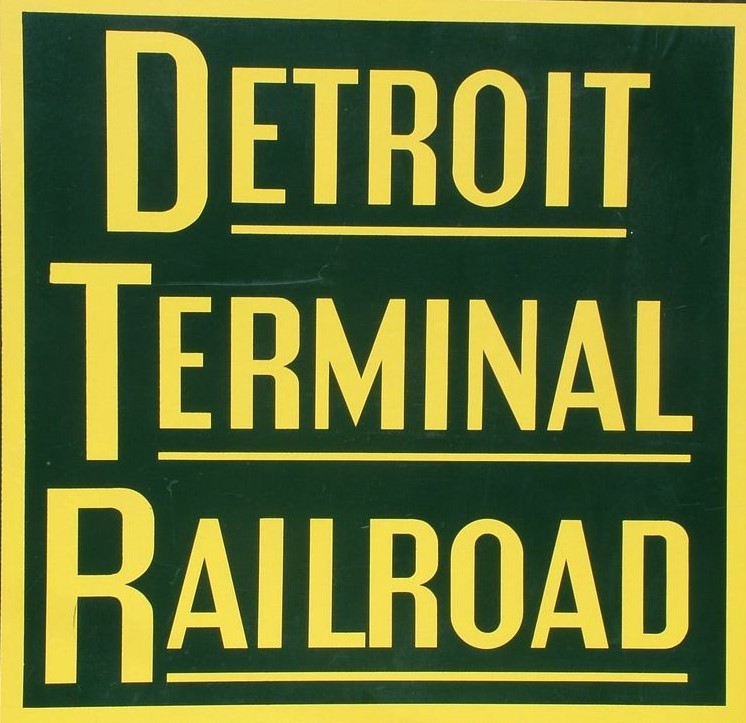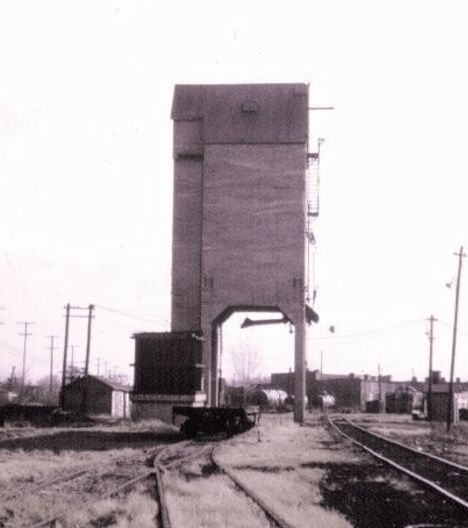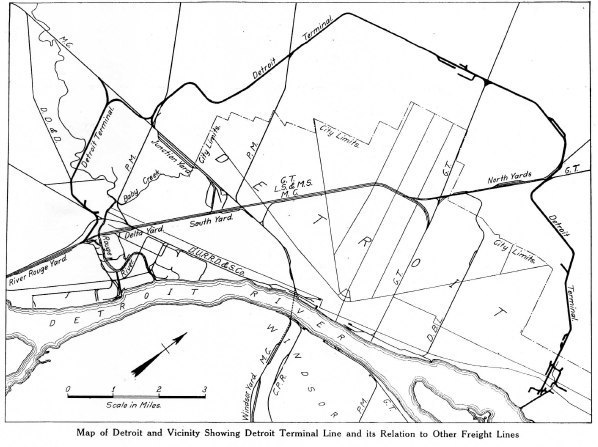- Details
- Hits: 3977
Railroad: Detroit Terminal Railroad Company
 The Detroit Terminal Railroad was a belt line around central Detroit which connected various industrial facilities on the ring around Detroit, including Chrysler plants on the Detroit River east of downtown, the Ford Highland Park plant and Rouge Works in Dearborn. The railroad was jointly owned by the Grand Trunk Western (50%) and Vanderbilt roads (Michigan Central and Lake Shore, each 25%). Most of the railroad was built between 1912 and 1914. In the 1980's the line started to be dismantled. The only sections retained today is from North Yard (Detroit) to a newer Chrysler Plant near East Jefferson Avenue, and a short section between the CSX and an industrial park at Wyoming Avenue in Dearborn.
The Detroit Terminal Railroad was a belt line around central Detroit which connected various industrial facilities on the ring around Detroit, including Chrysler plants on the Detroit River east of downtown, the Ford Highland Park plant and Rouge Works in Dearborn. The railroad was jointly owned by the Grand Trunk Western (50%) and Vanderbilt roads (Michigan Central and Lake Shore, each 25%). Most of the railroad was built between 1912 and 1914. In the 1980's the line started to be dismantled. The only sections retained today is from North Yard (Detroit) to a newer Chrysler Plant near East Jefferson Avenue, and a short section between the CSX and an industrial park at Wyoming Avenue in Dearborn.
Built → Detroit Terminal Railroad → Conrail
Built: 1905 as a joint venture between 3 railroads.
Operated for 76 years.
Became: Conrail in 1981
Reference: [MRRC]
 Notes
Notes
According to Schramm, et al in "When Eastern Michigan Rode the Rails", the idea for the Detroit Terminal railroad was credited to P.N. Jacobsen, a promoter of the Detroit, Monroe & Toledo Short Line (an electric road) who organized the DTRR in 1904. Officers of the Berry Varnish Company provided some initial funding. After the LSMS-MC and DGH&M-GTW provided funding for construction, the line was built starting in 1906 on the east side at the Detroit River, and then west as a "belt" through North Detroit, Highland Park, west Detroit and Dearborn. According to an early agreement, the MC operated the DT on behalf of the other railroads, until business on the DT warranted the purchase of their own equipment and hiring of employees. [EMR4]
Owned at incorporation by Grand Trunk Western (50%), Lake Shore & Michigan Southern (25%) and Michigan Central (25%).
This was an industrial belt railroad which served many automotive assembly and supplier plants in the cities of Dearborn, Detroit, Hamtramck and Highland Park.
Even though the railroad was owned by major roads, it had its own main yard and locomotive facilities called Davison Yard, which was between Highland Park and North Detroit. Those facilities now make up the Mound Road correctional facility and Detroit Intake Center.
Photo Info: The DT railroad Davison Yard coaling tower in 1964. [Charles Geletzke Jr. photo]. The map below is from 1914.
Time Line
1905. Directors of the Detroit Terminal Railroad Co. yesterday elected the following officers: Joseph H. Berry, president, Charles B. Warren, vice-president; William B. Cady, secretary, and W.G. Smith, treasurer. Work on the undertaking is to be pushed as fast as possible. [DFP-1905-1213] [Editors note: Berry was a Detroit industrialist, owning manufacturing, mining and lumber properties in Michigan, Ohio, New York and other states. He was a resident of Grosse Point Farms and said to have a fortune estimated to be more than $1 million (in 1905). [DFP]
1906. The Highland Park council has ordered its attorney to make a full investigation and report of what can be done to prevent the Detroit Terminal Railroad from crossing Woodward avenue near the Highland Park hotel at grade. The company has promised to separate the grades on Jefferson avenue in Fairview within a specified time but there is nothing to prevent it from crossing at grade at Mack, Gratiot and other crossings. [DFP-1906-0716]
1906. The Detroit Terminal railroad, the new outer line projected by and partially built by Joseph H. Berry, has been acquired by the Michigan Central, Lake Shore and Grand Trunk railroads, who will jointly own and operate it. Chairman Ledyard of the MC said the belt would first be constructed from the upper river end at Connor's Creek to the DGH&M tracks at Highland Park. [DFP-1906-1004]
1910. Extension of the DTRR, also known as the outer belt line, from the DGH&M in Highland Park west to a junction with the Pere Marquette tracks is scheduled to start today with construction of a wye for the junction with the DGH&M. Controlled by the MC and GT railroads, will run just north of the DUR's new Woodward car house. Owners of real estate in the vicinity, including Robert Oakman, who controls the Everitt 30 subdivision, anticipate a great increase in demand for factory sites west of Woodward avenue will follow completion of the outer belt line. [DFP-1910-0913]
1911. Detroit Terminal Railroad, completed in 1911, originally terminated in a wye-junction with Michigan Central Railroad (M.C.R.R.) in Dearborn, Michigan, just west of the c. 1892 single-track Pere Marquette Railroad (PM) overpass.
1912. W.D. Trump to head old Outer belt line. DT to be rebuilt and have new equipment. One of the most important changes looking to the relief of railroad traffic congestion in Detroit is scheduled to become effective November 1 when the Detroit Terminal, which serves more than 50 of the city's industrial plants, will be placed on an independent operating basis, with Trump, former general superintendent of the Pere Marquette, as manager and superintendent.
The change in the conduct of the railroad is part of the comprehensive scheme of rebuilding and equipment which the MC and GT systems have been carrying on during the summer. Heretofore the MC operated the east end and the GT the west end of the road. It has been decided that much more effective service will result through a plan of independent operation with a competent executive in charge. Railroads operating over it will also experience greater facility and efficiency. Trump has more than 30 years intimate railroad experience. [DFP-1912-0930]
1912. Regenerated, rehabilitated and reconstructed, the Detroit Terminal railroad felt the vibration of the first freight train to glide over its glistening new rails. Sixty cars loaded with 350 Ford automobiles and drawn by a brand new locomotive, DT engine No. 3, were shunted onto the tracks from the Ford factory sidings at 3 o'clock. The train proceeded to the MC north yards. [DFP-1912-1130]
1916. The Detroit Terminal railroad builds a new 100-ton coaling chute. [RR-1916-0101]
1918. The DT adds three stalls to its roundhouse. [RR-1918-0105]
1918. Charles Cast, chief of detectives for the Detroit Terminal railway discovered 75 men stealing coal from cars in the Warren Avenue yards. Kast emptied two revolvers into the air and although nobody "bit the dust", 11 men stopped running and surrendered. Kast flagged a passing switch engine, loaded his catch into a box car, and they headed for the Woodward avenue crossing in Highland Park five miles distant. They detrained and he marched them to Justice John Marshall's court where all were fined. [DFP-1918-0117]
1920. The Detroit Terminal serves 127 industries with 244 sidings and a car capacity of 2,546 cars. They have seven sets of team tracks which hold 280 cars and 2 freight houses. [DWT-1920]
1924. A single-track DTRR bridge was built over the M.C.R.R. mainline, connecting with yards further south and the then-new Ford River Rouge Complex.
1926. In presence of dozens of pedestrians and motorists, two Detroit Terminal railroad employees fought a duel at the corner of West Jefferson and Clark, with the result that one is dead and the other is in Delray Industrial hospital with wounds that are expected to prove fatal. The dead man, 40 years old, was a watchman for the railroad. The other, age 23, was an oiler for the road. The argument was over something that happened five years ago and they decided to settle it effectively. One of the stray bullets graced a man standing nearby. He was treated at Receiving hospital. [DFP-1926-1011]
1928. SNAPSHOT: During the last year, the railroad handled 691,814 cars of freight around Detroit. It keeps 36 switching engines and crews at work. William Trump continues as general manager and the presidency of the railroad alternates annually between local officials of the Grand Trunk and Michigan Central, the two owners. [DFP-1928-0303]
1936. William D. Trump, general manager of the Detroit Terminal railroad and a well known railroad man in Michigan, died in Henry Ford Hospital. [DFP-1936-0616]
1948. The 18 mile long Detroit Terminal railroad had 109 automobiles hit trains at grade crossings in 1947. Some were as the result of cars striking crossing warning signals, which were often located on the center line of the roadway. [DFP-1948-0409]
1949. With the receipt of two Electromotive diesel locomotives, the Detroit Terminal railroad is now completely "dieselized" announced Walter S. Smith, general manager. The railroad now operates 14 of the new-type engines, which have eliminated 22 steam locomotives that the line has operated since 1944. [DFP-1949-0526]
1956. A group of tower-climbing thieves stole 15,000 feet of 19-strand copper communications wire from overhead towers linking the Ford Motor Co. Rouge and Highland Park plants. The system, which has been replaced with underground cables, is being dismantled. Towers were stripped along Wyoming from the DT railroad tracks to West Warren and along Miller from Hagerty to the Expressway. Dearborn police said the wire was worth about $6,200 and probably would be cut up and sold for scrap. [DFP-1956-0605]
1962. The wye connection between DTRR and New York Central System’s mainline, straddling the north approach of the Miller Road Overpass, was eliminated in 1962.
1981. DTRR became part of Conrail on July 16, 1981. Nearly the entire one-time DTRR on Detroit's west side has been abandoned.
Map

Bibliography
The following sources are utilized in this website. [SOURCE-YEAR-MMDD-PG]:
- [AAB| = All Aboard!, by Willis Dunbar, Eerdmans Publishing, Grand Rapids ©1969.
- [AAN] = Alpena Argus newspaper.
- [AARQJ] = American Association of Railroads Quiz Jr. pamphlet. © 1956
- [AATHA] = Ann Arbor Railroad Technical and Historical Association newsletter "The Double A"
- [AB] = Information provided at Michigan History Conference from Andrew Bailey, Port Huron, MI

